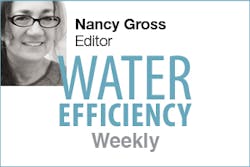One of our writers and I have been working on bringing our readers a water quality trading article, so I thought I would just introduce the topic and invite comments. EPA defines water quality trading this way:
Water quality trading is an innovative approach to achieve water quality goals more efficiently. Trading is based on the fact that sources in a watershed can face very different costs to control the same pollutant. Trading programs allow facilities facing higher pollution control costs to meet their regulatory obligations by purchasing environmentally equivalent (or superior) pollution reductions from another source at lower cost, thus achieving the same water quality improvement at lower overall cost.
Water quality trading is an innovative approach to achieve water quality goals more efficiently. Trading is based on the fact that sources in a watershed can face very different costs to control the same pollutant. Trading programs allow facilities facing higher pollution control costs to meet their regulatory obligations by purchasing environmentally equivalent (or superior) pollution reductions from another source at lower cost, thus achieving the same water quality improvement at lower overall cost.[text_ad] Our article will focus primarily on thermal credits. When treated wastewater, clean of all harmful contaminants, is discharged into the environment, its warmth may raise the temperature of the water beyond what is habitable for certain species. Regional regulatory bodies will have temperature regulations in place. Since riparian plantings can cool (and filter) the water, and provide shade that reduces the heat load from the sun, certain organizations are able to work with farmers and other landowners to make these plantings possible, and the wastewater treatment plant can purchase these credits in lieu of installing expensive and energy-intensive chillers at the point of discharge. I am only still learning the lay of the water quality trading land and welcome input from any knowledgable readers. An additional benefit when water quality trading is done through adding buffer zones of native plants is that habitats are restored. Birds and other animals that have all but vanished from a region may reappear in numbers, and the robust ecosystems can become centers for community relaxation and recreation. These are complex undertakings, planned in careful coordination with many stakeholders. The work is carried out scientifically. There are standards and models used that equate the number of trees planted to reduction in kilocalories per day. At the same time, there is an opportunity to benefit local economies, as plants are sourced from nurseries and workers are hired for the hands-on tasks. On a related note, please check out Forester University's upcoming "Stream Restoration Basics and Techniques," with sessions July 28 and 30. Here's a short intro; for more information click on one of the links.
Between balancing the complex physical and biological elements and attaining needed improvements, stream restoration can be challenging. Join two-time former IECA President, Dr. David T. Williams to brush up on your stream restoration basics in the final part of our Surface Water Master Class Series! In this two-session webinar, we’ll discuss the basic concepts, computations, roles, and techniques of a successful stream restoration project, and how you can put this into action on your team.
Our article will focus primarily on thermal credits. When treated wastewater, clean of all harmful contaminants, is discharged into the environment, its warmth may raise the temperature of the water beyond what is habitable for certain species. Regional regulatory bodies will have temperature regulations in place. Since riparian plantings can cool (and filter) the water, and provide shade that reduces the heat load from the sun, certain organizations are able to work with farmers and other landowners to make these plantings possible, and the wastewater treatment plant can purchase these credits in lieu of installing expensive and energy-intensive chillers at the point of discharge.
I am only still learning the lay of the water quality trading land and welcome input from any knowledgable readers. An additional benefit when water quality trading is done through adding buffer zones of native plants is that habitats are restored. Birds and other animals that have all but vanished from a region may reappear in numbers, and the robust ecosystems can become centers for community relaxation and recreation.
These are complex undertakings, planned in careful coordination with many stakeholders. The work is carried out scientifically. There are standards and models used that equate the number of trees planted to reduction in kilocalories per day. At the same time, there is an opportunity to benefit local economies, as plants are sourced from nurseries and workers are hired for the hands-on tasks.
On a related note, please check out Forester University’s upcoming “Stream Restoration Basics and Techniques,” with sessions July 28 and 30. Here’s a short intro; for more information click on one of the links.
Between balancing the complex physical and biological elements and attaining needed improvements, stream restoration can be challenging.
Join two-time former IECA President, Dr. David T. Williams to brush up on your stream restoration basics in the final part of our Surface Water Master Class Series! In this two-session webinar, we’ll discuss the basic concepts, computations, roles, and techniques of a successful stream restoration project, and how you can put this into action on your team.
